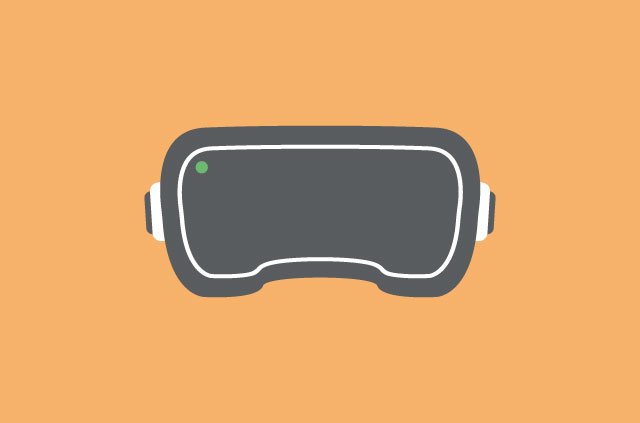Virtual reality technology has been a talking point for a few years now without really breaking through to the mainstream.
Sure, the market is growing. The market size of VR and AR is projected to reach 17 billion USD this year, and 160 billion USD by 2023. Consumer spending makes up the largest market segment and includes devices such as the Oculus Rift and the HTC Vive.
But it’s still unclear what the killer app for VR might be, in the same way that productivity applications like Microsoft Office drove PC sales, or how a combination of music and communication apps helped fuel the adoption of smartphones.
Lots of analysts had speculated that gaming would be the push VR devices needed by offering audiences an immersive experience that current handheld platforms or consoles lack. Samsung and Sony have both invested considerable sums of cash in building and promoting their headsets.
However, the first generation of Samsung’s Galaxy Gear took me back to the early days of Atari and the heavily pixelated experience of games like Space Invaders. Sony hasn’t performed much better, with only about 2 million headsets sold, when there are 70 million compatible PlayStation 4 consoles out there.
These behemoths haven’t quite gotten it right. The jury’s still out on Facebook’s purchase of Oculus, with the social networking giant declining to release any hard sales numbers.
But as Wired noted last year, there’s more to VR than gaming. Possible applications include training videos for forklift operators, fitness programs, and streamable video, including live sporting events that would put viewers in the center of a game.
Still, VR has yet to hit the right mark and appears to be floundering.
Innovative storytelling
So when I had the opportunity to attend the Festival of International Virtual and Augmented Reality Stories (FIVARS) in Toronto last week, I didn’t expect much. The showcases focused on storytelling: Put on a headset, and be immersed in a virtual-reality film.
It’d be cool to support the event, I told myself as I shelled out about 40 USD for a two-hour VR experience. Beyond that, I just expected to be underwhelmed.
The format of the festival was such that each pass gave you a two-hour window to sample the experiences on offer. Every attendee was given eight tickets to use at the show, with each experience costing one to three tickets.
As I walked around the Toronto Media Arts Centre examining the experiences on offer, I was drawn to Everest, a story about two people attempting to climb the world’s highest mountain without the use of bottled oxygen.
I’ve been fascinated with mountains since childhood and have never had the privilege of visiting Nepal, so it seemed like a no-brainer. The headset used was the new Samsung Galaxy Gear VR which, incidentally, is powered by Oculus.
I won’t go into too many details about the cinematic experience itself, but the storytelling hit it out of the park. It was the first time that I experienced six degrees of freedom—the ability to move around freely and look in all directions.
The Everest expedition was captured in 8K 3D Ambisonic Audio Virtual Reality, and it showed. From close-ups of the mountaineers’ treacherous journey, such as the vast crevasses they had to navigate, to the living conditions inside their tent, as well as the final ascent to the summit, it truly felt as if I was part of the expedition.
Off to a promising start.
I tried other experiences too, including After Dan Graham, described as an interactive art installation, and 12 Seconds of Gunfire, about a school shooting. They weren’t bad but didn’t really leave me awestruck. However, my final immersive foray, Holy City, was another example of how powerful VR can be as a storytelling medium.
The interactive experience takes you inside Jerusalem, a city that holds immense significance for all four of the major Abrahamic faiths. I heard perspectives from a Rabbi, a Priest, and a Muslim Sufi. I was teleported to the Western Wall, one of Judaism’s holiest sites. And I learned so much about the history of the city that I now feel compelled to visit it in person as soon as I can.
Creativity beyond gaming
“We started FIVARS because we wanted to test the creative limits of a new medium and avoid the most obvious clichés for its application,” says Keram Malicki-Sanchez, a filmmaker and the director of FIVARS, which is now in its fifth year.
“By opening the doors to an international community, we welcomed the opportunity to learn from people working in different territories, sensibilities, cultures and technologies.”
Keram remains upbeat about the future of VR/AR, but says people need to leave behind their narrow notions of what the technology is and how it is used.
“The use cases will be ubiquitous. We will leverage these tools in every aspect of our lives, from the simulation of environments, climates, societies, physical applications… to concepts and experiences that current media cannot afford access to,” he says. “We will be able to conceive concepts that are very hard to portray currently, in physics, in philosophy, and so on.”
While Malicki-Sanchez is considerably more enthusiastic about immersive technologies than I am, just two hours of VR storytelling turned me from a skeptic into an optimist. And that’s definitely a step in the right direction.


























